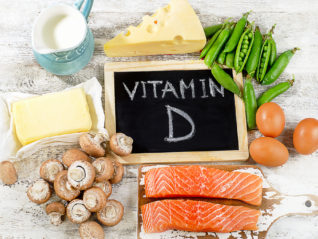
by Ashley Jordan Ferira, PhD, RDN
Vitamin D is essential- it helps absorb calcium, supports nervous and muscle tissue, and the immune system. Compared to normal-weight counterparts, vitamin D deficiency is more prevalent in those with obesity. In the US over one-third of adults meet obesity criteria.1
A study in The Journal of Clinical Endocrinology and Metabolism2 examined cellular mechanisms of vitamin D trafficking in metabolically dysfunctional adipose tissue as compared to normal adipocytes in conjunction with a vitamin D supplementation intervention in a randomized, controlled trial.
Ninety-seven male subjects completed the vitamin D intervention study. Fifty-four normal-weight and 67 obese males were initially randomized to receive either 50 mcg/week of 25-hydroxyvitamin-D3 [25(OH)D3] (2,000 IU/week equivalent) or 150 mcg/week of vitamin D3 (6,000 IU/week equivalent) for one year. Vitamin D sufficiency was defined as a 25(OH)D blood level > 20 ng/ml. This serum concentration is aligned with the National Academy of Medicine’s cutoff for vitamin D sufficiency.3
Vitamin D uptake, conversion and release were investigated in control (non-insulin-resistant) and insulin-resistant 3T3-L1 adipocytes, as well as in subcutaneous adipose tissue (SAT) samples from lean and obese participants. The release of vitamin D and its metabolites were induced with the addition of adrenaline. Expression of the vitamin D receptor and vitamin D conversion enzymes, 25-hyroxylase and 1α-hydroxylase, was also examined.
The research team elucidated key differences in cellular vitamin D trafficking effects and supplementation effects:
- Uptake of vitamin D3 and 25(OH)D3 was higher in insulin-resistant adipose cells vs. control cells
- Conversely, the adrenaline-stimulated release of D3 and 25(OH)D3 from insulin-resistant adipocytes was impaired when compared to control cells
- Additionally, the cellular conversions of vitamin D3 to 25(OH)D3 and to the active 1,25(OH)2D3 form were impaired in insulin-resistant adipocytes when compared to control cells
- Blunted release of D3 and 25(OH)D3 was also seen in obese SAT when compared to lean SAT
- Control adipocytes demonstrated higher expression of vitamin D conversion enzymes, 25-hyroxylase and 1α-hydroxylase, than insulin-resistant adipocytes
- Clinically, weekly 25(OH)D3 supplementation (vs. the traditional vitamin D3supplementation approach) was more efficacious at achieving sufficient vitamin D levels in obese patients, but this advantage was not observed in normal-weight subjects
Why is this Clinically Relevant?
- Higher adiposity is consistently associated with vitamin D deficiency and should be recognized as a modifiable risk factor for hypovitaminosis D
- Key differences in cellular mechanisms of vitamin D trafficking exist in insulin-resistant adipose cells vs. normal adipocytes, as well as in subcutaneous tissue in obese vs. lean patients
- Clinical efforts to improve the prevention and treatment of obesity and cardiometabolic dysfunction are paramount
- 25-hydroxyvitamin-D3 supplementation may be more efficacious than the traditional vitamin D3 approach in combating vitamin D deficiency in obese patients, although additional research is warranted for confirmation and to inform future clinical practice guidelines
References
- CDC. Overweight & Obesity. https://www.cdc.gov/obesity/adult/index.html. Accessed October 5, 2017.
- Di Nisio A, De Toni L, Sabovic I, et al. Impaired release of vitamin D in dysfunctional adipose tissue: new cues on vitamin D supplementation in obesity. J Clin Endocrinol Metab. 2017;102(7):2564-2574.
- National Academy of Medicine. Food and Nutrition Board. Dietary Reference Intakes for Calcium and Vitamin D. National Academy Press. Washington, D.C. 2010.



